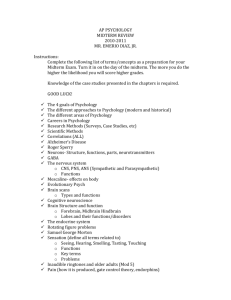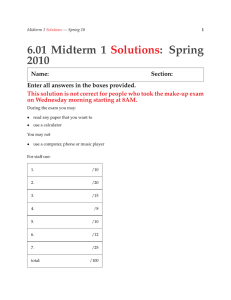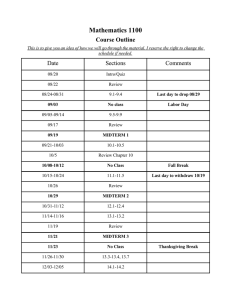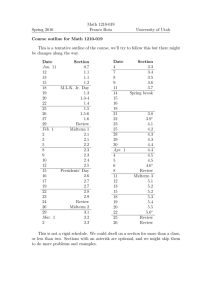6.01 Name: Section: Enter
advertisement
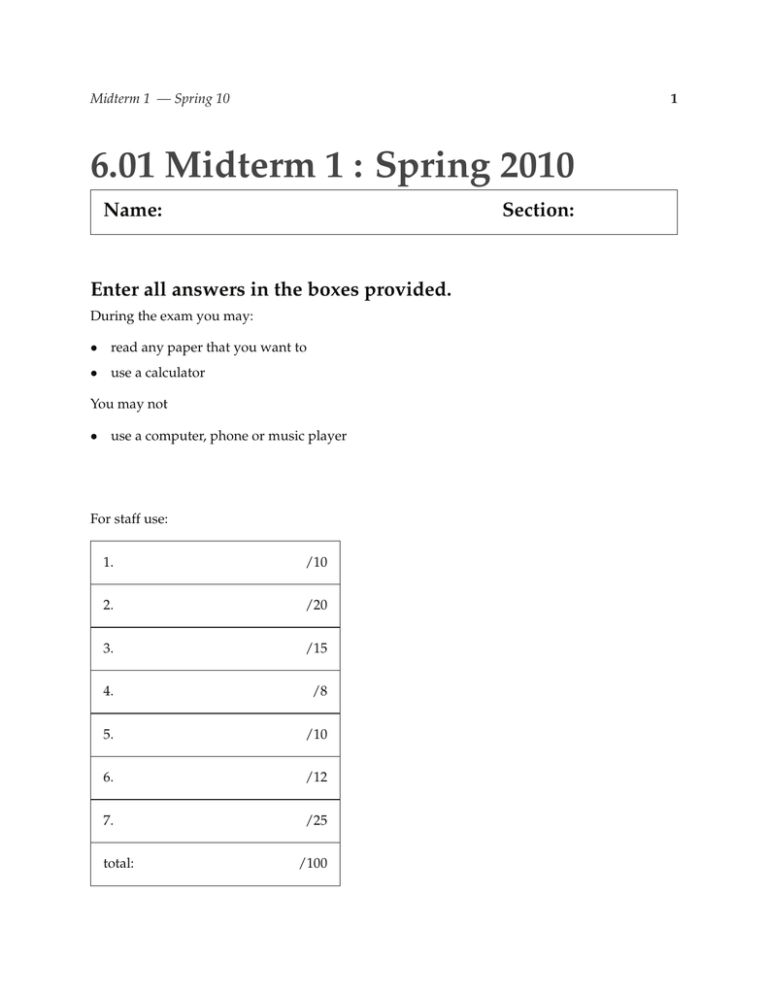
Midterm 1 — Spring 10 1 6.01 Midterm 1 : Spring 2010 Name: Section: Enter all answers in the boxes provided. During the exam you may: • read any paper that you want to • use a calculator You may not • use a computer, phone or music player For staff use: 1. /10 2. /20 3. /15 4. /8 5. /10 6. /12 7. /25 total: /100 Midterm 1 — Spring 10 2 1 OOP (10 points) The following definitions have been entered into a Python shell: class A: yours = 0 def __init__(self, inp): self.yours = inp def give(self, amt): self.yours = self.yours + amt return self.yours def howmuch(self): return (A.yours, self.yours) class B(A): yours = 0 def give(self, amt): B.yours = B.yours + amt return A.howmuch(self) def take(self, amt): self.yours = self.yours - amt return self.yours def howmuch(self): return (B.yours, A.yours, self.yours) Write the values of the following expressions. Write None when there is no value; write Error when an error results and explain briefly why it’s an error. Assume that these expressions are evaluated one after another (all of the left column first, then right column). test = A(5) test = B(5) test.take(2) test.take(2) test.give(6) test.give(6) test.howmuch() test.howmuch() Midterm 1 — Spring 10 3 2 The Best and the Brightest (20 points) Here are some class definitions, meant to represent a collection of students making up the student body of a prestigious university. class Student: def __init__(self, name, iq, salary, height): self.name = name self.iq = iq self.salary = salary self.height = height class StudentBody: def __init__(self): self.students = [] def addStudent(self, student): self.students.append(student) def nameOfSmartest(self): # code will go here def funOfBest(self, fun, feature): # code will go here The StudentBody class is missing the code for two methods: • nameOfSmartest: returns the name attribute of the student with the highest IQ • funOfBest: takes a procedure fun and a procedure feature as input, and returns the result of applying procedure fun to the student for whom the procedure feature yields the highest value For the first two problems below, assume that these methods have been implemented. Here is a student body: jody = Student(’Jody’, 100, 100000, 80) chris = Student(’Chris’, 150, 40000, 62) dana = Student(’Dana’, 120, 2000, 70) aardvarkU = StudentBody() aardvarkU.addStudent(jody) aardvarkU.addStudent(chris) aardvarkU.addStudent(dana) Midterm 1 — Spring 10 4 1. What is the result of evaluating aardvarkU.nameOfSmartest()? 2. Write a Python expression that will compute the name of the person who has the greatest value of IQ + height in aardvarkU (not just for the example student body above). You can define additional procedures if you need them. 3. Implement the nameOfSmartest method. For full credit, use util.argmax (defined below) or the funOfBest method. If l is a list of items and f is a procedure that maps an item into a numeric score, then util.argmax(l, f) returns the element of l that has the highest score. Midterm 1 — Spring 10 4. Implement the funOfBest method. For full credit, use util.argmax. Repeated from the start of the problem: class Student: def __init__(self, name, iq, salary, height): self.name = name self.iq = iq self.salary = salary self.height = height class StudentBody: def __init__(self): self.students = [] def addStudent(self, student): self.student.append(student) def deleteStudent(self, student): self.students.remove(student) def nameOfSmartest(self): pass def funOfBest(self, fun, feature): pass Here is a student body: jody = Student(’Jody’, 100, 100000, 80) chris = Student(’Chris’, 150, 40000, 62) dana = Student(’Dana’, 120, 2000, 70) aardvarkU = StudentBody() aardvarkU.addStudent(jody) aardvarkU.addStudent(chris) aardvarkU.addStudent(dana) 5 Midterm 1 — Spring 10 6 3 SM to DE (15 Points) Here is the definition of a class of state machines: class Thing(SM): startState = [0, 0, 0, 0] def getNextValues(self, state, inp): result = state[0] * 2 + state[2] * 3 newState = [state[1], result, state[3], inp] return (newState, result) 1. What is the result of evaluating Thing().transduce([1, 2, 0, 1, 3]) 2. The state machine above describes the behavior of an LTI system starting at rest. Write a difference equation that describes the same system as the state machine. Midterm 1 — Spring 10 7 4 Diagnosis (8 points) What, if anything, is wrong with each of the following state machine definitions? The syntax is correct (that is, they are all legal Python programs), so that is not a problem. Write a phrase or a single sentence if something is wrong or “nothing” if nothing is wrong. 1. class M1(SM): startState = 0 def getNextValues(self, state, inp): return inp + state 2. class M2(SM): startState = 0 def getNextValues(self, state, inp): return (inp+state, (state, state)) Midterm 1 — Spring 10 3. class M3(SM): def __init__(self): self.startState = [1, 2, 3] def getNextValues(self, state, inp): state.append(inp) result = sum(state) / float(len(state)) return (result, state) 4. class M4(SM): startState = -1 def __init__(self, v): self.value = v def getNextValues(self, state, inp): if state > inp: self.value = self.value + state result = self.value * 2 return (state, result) 8 Midterm 1 — Spring 10 9 5 Picture to Machine (10 Points) Use sm.Gain, sm.Delay, sm.FeedbackAdd, sm.FeedbackSubtract, and sm.Cascade to make a state machine that is equivalent to the following system: X k1 + − R k2 + Y − R R R Assume that the system starts at rest, that is, all the signals are zero at time zero. Assume also that the variables k1 and k2 are already defined. Recall that sm.Gain takes a gain as an argument, sm.Delay takes an initial output value as an argument and each of sm.Cascade, sm.FeedbackAdd, and sm.FeedbackSubtract, takes two state machines as arguments. Use indentation to highlight the structure of your answer. Midterm 1 — Spring 10 10 6 On the Verge (12 Points) For each difference equation below, say whether, for a unit sample input signal: • the output of the system it describes will diverge or not, • the output of the system it describes (a) will always be positive, (b) will alternate between positive and negative, or (c) will have a different pattern of oscillation 1. 10y[n] − y[n − 1] = 8x[n − 3] diverge? Yes or No positive/alternate/oscillate 2. y[n] = −y[n − 1] − 10y[n − 2] + x[n] diverge? Yes or No positive/alternate/oscillate Midterm 1 — Spring 10 11 7 What’s Cooking? (25 Points) Sous vide cooking involves cooking food at a very precise, fixed temperature T (typically, low enough to keep it moist, but high enough to kill any pathogens). In this problem, we model the behavior of the heater and water bath used for such cooking. Let I be the current going into the heater, and c be the proportionality constant such that Ic is the rate of heat input. The system is thus described by the following diagram: I c + T + Delay k1 1. a. Give the system function: H = T I Delay = b. Give a difference equation for the system: T [n] = k2 Midterm 1 — Spring 10 12 2. Let the system start at rest (all signals are zero). Suppose I[0] = 100 and I[n] = 0 for n > 0. Here are plots of T [n] as a function of n for this system for c = 1 and different values of k1 and k2 . 200 200 150 150 100 100 50 50 5 10 15 5 �50 10 15 10 15 10 15 �50 a b 200 200 150 150 100 100 50 50 5 10 15 5 �50 �50 c d 200 200 150 150 100 100 50 50 10 5 15 5 �50 �50 f e a. Which of the plots above corresponds to k1 = 0.5 and k2 = 0 ? Circle all correct answers: a b c d e f none b. Which of the plots above corresponds to k1 = 1 and k2 = 0.5 ? Circle all correct answers: a b c d e f none Midterm 1 — Spring 10 3. Let k1 = 0.5, k2 = 3, and c = 1. Determine the poles of H, or none if there are no poles. 13 Midterm 1 — Spring 10 14 4. Here is the original system: I c + T + Delay k1 Delay k2 Circle all of the following systems that are equivalent (for some setting of the gains in the triangles) to the original system. a b c d e MIT OpenCourseWare http://ocw.mit.edu 6.01SC Introduction to Electrical Engineering and Computer Science Spring 2011 For information about citing these materials or our Terms of Use, visit: http://ocw.mit.edu/terms.

